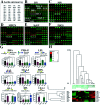Alteration of glycosylation in serum proteins: a new potential indicator to distinguish non-diabetic renal diseases from diabetic nephropathy
- PMID: 35558281
- PMCID: PMC9090655
- DOI: 10.1039/c8ra06832a
Alteration of glycosylation in serum proteins: a new potential indicator to distinguish non-diabetic renal diseases from diabetic nephropathy
Abstract
Diabetic nephropathy (DN) and nondiabetic renal disease (NDRD) are two major categories of renal diseases in diabetes mellitus patients. The clinical differentiation among them is usually not so clear and effective. In this study, sera from DN and NDRD patients were collected, and glycan profiles of serum proteins from DN and NDRD patients were investigated and compared by using lectin microarray and lectin blot. Then, altered glycoproteins were enriched by lectin coupled magnetic particle conjugate and characterized by LC-MS/MS. We found significant change in glycan patterns between DN and NDRD patients. In particular, the relative abundance of the glycopattern of Galβ1-3GalNAc which was identified by BPL (Bauhinia purpurea lectin) was significantly decreased in DN patients compared to four types of NDRD patients (p < 0.05). Moreover, BPL blotting indicated that the proteins with a molecular weight of about 53 kDa exhibited low staining signal in DN compared to all NDRD groups, which was consistent with results of lectin microarrays. After enriching by BPL and identification by LC-MS/MS, a total of 235 and 258 proteins were characterized from NDRD and DN respectively. Among these, the relative abundance of 12 isolated serum proteins exhibited significantly alteration between DN and NDRD (p < 0.05). Our findings indicated not only the relative abundance of Galβ1-3GalNAc on serum proteins but also certain glycoproteins modified with this glycopattern showed a difference between DN and NDRD patients. This suggested that the analysis of this alteration by using urine specimens may constitute an additional valuable diagnostic tool for differentiating DN and NDRD with a non-invasive method.
This journal is © The Royal Society of Chemistry.
Conflict of interest statement
The authors declare no conflict of interest.
Figures




Similar articles
-
Potential Value of Datura stramonium Agglutinin-recognized Glycopatterns in Urinary Protein on Differential Diagnosis of Diabetic Nephropathy and Nondiabetic Renal Disease.Chin Med J (Engl). 2018 Jan 20;131(2):180-187. doi: 10.4103/0366-6999.222328. Chin Med J (Engl). 2018. PMID: 29336366 Free PMC article.
-
[The clinicopathological characteristics of diabetic nephropathy and non-diabetic renal diseases in diabetic patients].Zhonghua Nei Ke Za Zhi. 2017 Dec 1;56(12):924-929. doi: 10.3760/cma.j.issn.0578-1426.2017.12.007. Zhonghua Nei Ke Za Zhi. 2017. PMID: 29202533 Chinese.
-
Clinicopathological characteristics of non-diabetic renal disease in patients with type 2 diabetes mellitus in a northeastern Chinese medical center: a retrospective analysis of 273 cases.Int Urol Nephrol. 2016 Oct;48(10):1691-8. doi: 10.1007/s11255-016-1331-y. Epub 2016 Jun 6. Int Urol Nephrol. 2016. PMID: 27272256 Free PMC article.
-
Non-diabetic renal disease (NDRD) in patients with type 2 diabetes mellitus (type 2 DM).J Assoc Physicians India. 2013 Mar;61(3):194-9. J Assoc Physicians India. 2013. PMID: 24475681 Review.
-
[Non-diabetic renal disease in type II diabetes mellitus].Zhongguo Yi Xue Ke Xue Yuan Xue Bao. 2003 Feb;25(1):101-4. Zhongguo Yi Xue Ke Xue Yuan Xue Bao. 2003. PMID: 12905620 Review. Chinese.
Cited by
-
Fibrinogen Fucosylation as a Prognostic Marker of End-Stage Renal Disease in Patients on Peritoneal Dialysis.Biomolecules. 2020 Aug 9;10(8):1165. doi: 10.3390/biom10081165. Biomolecules. 2020. PMID: 32784866 Free PMC article.
-
Cell-based HTS identifies a chemical chaperone for preventing ER protein aggregation and proteotoxicity.Elife. 2019 Dec 17;8:e43302. doi: 10.7554/eLife.43302. Elife. 2019. PMID: 31843052 Free PMC article.
-
Salivary Glycopatterns as Potential Non-Invasive Biomarkers for Diagnosing and Reflecting Severity and Prognosis of Diabetic Nephropathy.Front Endocrinol (Lausanne). 2022 Mar 31;13:790586. doi: 10.3389/fendo.2022.790586. eCollection 2022. Front Endocrinol (Lausanne). 2022. PMID: 35432212 Free PMC article.
-
Capitalizing glycomic changes for improved biomarker-based cancer diagnostics.Explor Target Antitumor Ther. 2023;4(3):366-395. doi: 10.37349/etat.2023.00140. Epub 2023 Jun 28. Explor Target Antitumor Ther. 2023. PMID: 37455827 Free PMC article. Review.
References
LinkOut - more resources
Full Text Sources
Other Literature Sources

